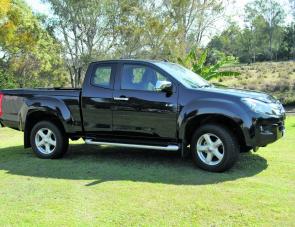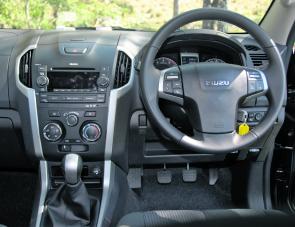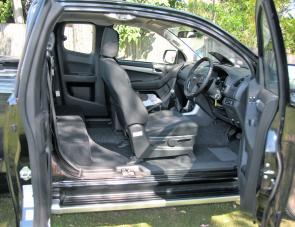The 2013 Isuzu D-Max LS has undergone its first upgrade of body styling since its original release in 2008. And what a transformation! New body shape, upgraded engine specs, and even a ladder frame chassis platform.
As usual there are a plethora of models to choose from; 22 variants, all powered by the upgraded 3L intercooled diesel engine outputting 130kW of power, 380Nm of torque. Transmission is either five-speed auto or five-speed manual.
The D-Max has been developed alongside fellow traveller Colorado. They share similar interior design and the same ladder chassis platform, but have different exteriors, engines and drive trains.
The new 2013 model D-Max is an attractive vehicle with substantial front end changes, such as bold looking guards, a neat grille and a new head-light layout. The rear, as you would expect, is strictly generic work ute with a 1 tonne carrying capacity and 3 tonne braked towing capability.
Behind the passenger compartment there are straight sides to the tray, LED tail lights, and a drop down tail gate. This is very typical of most utes in its class, such as Hilux, Amarok, Navara, Triton, Mazda BT-50 and Ford Ranger.
The new D-Max 2013 model’s styling is by no means polarising or provocative, rather the only statement it makes is to invite closer scrutiny.
The LS Space Cab main seating is for two adults in the front with room for a couple more passengers behind on two pull down jump seats. Alternatively, this rear area can be used for storage, as we did on a recent trip to St George. Even with front seats well back there was still a good deal of room.
My wife, Denise, and I found the D-Max front seats very well shaped – highly satisfactory for a 7 hour run. They were quite supportive and the driver’s seat offers height adjustment as a bonus.
Overall, the interior of the LS four door ute is pretty much a work vehicle. There is a fair amount of plastic throughout the dash area, although the floor was carpeted and a leather wrap graced the steering wheel. A large glove box was standard, with an in-dash compartment just behind the windscreen for smaller ready use items, such as phone, wallet. The vehicle had a fair number of handy storage areas throughout.
Controls for the pollen filter air conditioning system were easy to use, while iPod and Bluetooth connectivity (the latter being wheel mounted) were standard fare. The Isuzu’s cruise control system was located on the right side of the wheel’s T-piece.
We had some country touring in mind, so we loaded up mega camping gear into the 1823mm long, 1552mm wide, 465mm deep double walled tray of the Isuzu (and as much as we could cram into the rear seating area as well) and headed off to the St George area to check out the region’s fishing potential.
The fairly long first stage from Brisbane to Goondiwindi was very easily handled with not the slightest bit of discomfort noticed. The Isuzu’s suspension has independent double wishbone, coil springs and gas shocks up front, with over-slung long leaf springs at the rear that soaked up any undulations on the Millmerran to Goondiwindi stretch admirably. Later, it also proved just as pliable and easy to live with on gravel roads.
Even though there was a decent load in the rear tray, the empty Isuzu was still very easy by no means hard riding; there’s obviously some smart spring calibration there.
On the long pull up the Tollbar Range the quite smooth and very tractable 3L intercooled turbo diesel surprised me with its flexibility. This engine is not the largest in its class, but then does it need to be? Mated to a five-speed manual gear box in the reviewed D-Max, the four cylinder engine/drive train combination was in some respects better to use than some six speed boxes I’ve encountered. It was very pleasing that correct gears were found every time, the clutch also light but very positive to use.
While in Cruise Control mode the Isuzu D-Max showed no tendency to drop down gears or hunt for extra revs when tackling an incline. The tacho hardly ever moved, the powerful diesel just took it all in its stride and hummed along sweetly.
Peak torque arrives at 1800rpm; this means the engine has very little turbo lag and with the gearing from the five speed box well matched to the engine it’s very under-stressed. Cruising on 110km/h saw the tacho at just over 2000rpm.
Fuel consumption was brilliant. Isuzu claim around 8L per 100km for urban work and my recorded 8.3L per 100km went very close indeed. With a 76L tank, a cruise range of 900km could be expected.
Isuzu have also installed a new 4x4 engagement system for 2013. A console-mounted knob offers the choice of two or four wheel drive at speeds up to 100km/h.
D-Max standard safety features include six airbags, high strength passenger safety cell, collapsible steering column and brake pedal, ESC, ABS, with electronic brake force distribution, and brake assist system. The LS model’s excellent projector headlights are also worth mentioning.
Warranty is standard at 3 years or 100,000km. Price of the LS space Cab as reviewed was a competitive $43,700.
Reads: 7331
New styling sets the new D-Max apart from its predecessor.

Loaded to the hilt: the D-Max on the banks of the Balonne River at St George.

Despite being a work ute, its trim and the general dash layout was of a high standard.

With the pair of drop down rear seats out of the way, additional storage space within the cabin is a handy asset.

The Space Cab is aptly named, with plenty of storage and legroom available.




